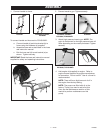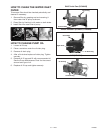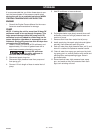
Pressure Adjustment
The pressure setting is preset at the factory to achieve
optimum pressure and cleaning. If you need to
lower the pressure, it can be accomplished by
these methods.
1. Back away from the surface to be cleaned.
The further away you are, the less the pressure
will be on the surface to be cleaned.
2. Reduce the speed of the gasoline engine
(RPM). Slow the engine down and the water
pressure will go down with it.
Step 3 is for models PCH2627, PCH3030 and
PCH3540HR.
3. Adjust the pressure regulator on the pump. Turn the
pressure regulator knob counterclockwise to lower pres-
sure. Refer to the illustrations to identify your pressure
regulator.
Once you have finished using your pressure washer, re-
turn the pressure regulator to its original position by
turning it clockwise.
DO NOT attempt to
increase pump pres-
sure. A higher pressure setting than the
factory set pressure may damage pump.
DO NOT try to turn
pressure regulator knob
past the built-in stop or damage to pump
will result.
10 — ENG
D22885
HOW TO USE WAND
For Multi-Reg Wands (PCV2021):
Your pressure washer is equipped with a multi-reg
wand with both high and low pressure settings. The
high pressure setting is for cleaning and rinsing, the
low pressure setting is for applying chemicals or
cleaning solutions to surfaces.
RISK OF INJECTION OR
INJURY TO PERSON.
DO NOT DIRECT DISCHARGE STREAM
TOWARD PERSONS.
WHEN USING THE HIGH
PRESSURE SETTING,
DO NOT ALLOW THE JET-LIKE SPRAY TO
COME IN CONTACT WITH UNPROTECTED
SKIN, EYES, OR WITH ANY PETS OR ANI-
MALS. SERIOUS INJURY CAN OCCUR.
For high pressure operation, pull back the nozzle of
the multi-reg wand as shown.
The nozzle at the end of the multi-reg wand can be
rotated to change the high pressure spray pattern
from a narrow jet to a 40º fan shape, as shown.
Markings have been placed on the nozzle to help you
select the spray pattern.
For low pressure operation, extend the nozzle of the
multi-reg wand as shown.
40º fan spray
narrow jet stream
Thermal Relief Valve
In an effort to prevent damage,
pumps are equipped with a
thermal relief valve. This valve
will open when the temperature
inside the pump rises too high.
This valve will then release a
gush of water in an effort to
lower the temperature inside the
pump. Immediately after this
occurs, the valve will close.
DO
NOT
allow your unit to operate
in bypass mode for more than two minutes
at any time. Overheating of pump will
cause damage to pump.


















